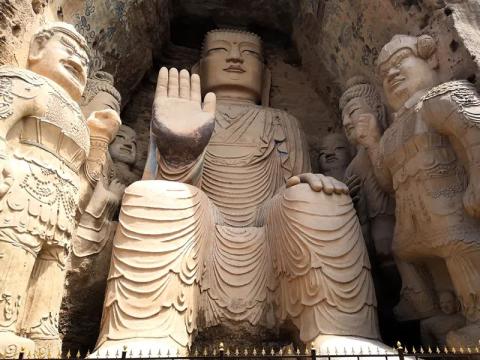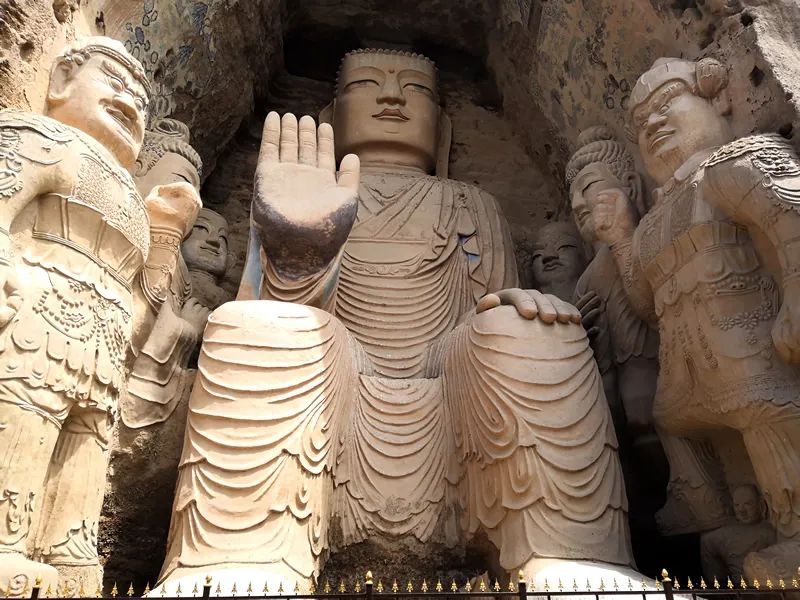
Since ancient times, Gansu has been said to be the most powerful place of gold, Zhangye, silver and martial arts. It is also a place worth traveling to. Wuwei, known as Liangzhou in ancient times, is a city with great history and culture. The capital of the northwest and the hometown of Liang Kingdom. Liangzhou was once the third largest city, the place that countless people yearned for, and the land where horses and flying swallows were born.
Attractions
"Tianti Mountain Grottoes"

Founded in Northern Liang during the Sixteen Kingdoms, it is large in scale and majestic in architecture and is known as the originator of Chinese grottoes. There are hundreds of square meters of murals preserved in the cave, three floors of the cave, 17 Buddhist niches, more than 100 Buddha statues, as well as Han and Tibetan scriptures from the Wei, Sui and Tang dynasties. Among them, the seated statue of Tathagata in the Big Buddha Cave has a lifelike look and is very shocking. It is 50 kilometers away from Wuwei city.
"Leitai Han Tomb"

The Chinese tourism symbol Horse Treading on a Flying Swallow was unearthed from here. It has a history of more than 1,800 years. You can visit it.
"Wuwei Confucian Temple"

It is the Confucius Temple in Wuwei. Built in the second to fourth years of the Ming Dynasty, it is the majestic, largest and best-preserved Confucius temple in the northwest region. It is also one of the three largest Confucius temples in the country. It is still helpful for us to understand history and culture. On Chongwen Street.
"Temple of Paradise"


It is located in Tiantang Town, Tianzhu County, Wuwei City, 200 kilometers away from Wuwei City and 92 kilometers away from Tianzhu County. Tiantang Temple is very important in the minds of Tianzhu Tibetans. It is a holy place where legends were born and full of yearning. This was once the cradle of the growth of the nomadic people in the Huare Tibetan area, and it was also one of the very famous Tibetan Buddhist temples in the Gansu-Qinghai-Tibet area. Tiantang Temple has a long history and a large scale. In its heyday, there were more than a thousand monks here. When important Buddhist activities were held, the surrounding area of Tiantang Temple was filled with fluttering white prayer flags, rising green mulberry smoke, and the sound of chanting sutras. , the sound of drums is endless, and prayers come in droves. In the minds of Tianzhu Tibetans, Tiantang Temple is no less than the Potala Palace thousands of miles away.
"Liangzhou Baita Temple"

It is a historical witness that Tibet belongs to the motherland. It was built in the Yuan Dynasty and has a history of more than 760 years. Important Tibetan Buddhist monastery ruins in the Hexi Corridor. Baita Temple has very important historical value. It is also a witness to the history and culture of Wuwei. It is located in Baita Village, Wunan Town, 20 kilometers southeast of Wuwei City.
"Roshi Temple Tower"

The Roshi Temple Pagoda is located on North Street in Wuwei City. It was built to commemorate Kumarajiva, an eminent monk from the Western Regions, who promoted Buddhism and translated classics in Wuwei. The Roshi Temple Pagoda has octagonal twelve floors and is 32 meters high. Luoshi Temple Tower and the twin towers in the northeast corner of Wuwei City face each other from a distance, forming the "Three Peaks of Wenbi" and one of the eight scenic spots in Liangzhou.
"Haizang Temple"

Haizang Temple, also known as Qinghua Zen Temple, was first built in Jin Dynasty and has a history of more than 1,700 years. It is one of the more complete ancient buildings preserved in the Hexi Corridor and is known as the "Crown of the Vatican Palaces in the Northwest". It is said that in the past, there were dense woods and springs around the temple, and the temple was built among them, just like a Zen temple hidden in the "sea", so it was named Haizang Temple.
"Hongyashan Reservoir"

Minqin County in Wuwei, known as the Pearl of the Sand Sea, is located on the lower reaches of the Shiyang River and surrounded by the two major deserts of Tengger and Badain Jaran. It is 60 kilometers away from Wuwei City and 30 kilometers away from Minqin County. A desert depression water storage project, the largest desert reservoir in Asia.
"Ma Ya Snow Mountain"

It is called Anigazhuo in Tibetan. It is in the west of Tianzhu County, 35 kilometers away from Tianzhu County. It runs northwest-southeast, about 45 kilometers long from east to west, and about 10 kilometers wide from north to south. The main peak is called Lunbusze in Tibetan, which means the highest. Mount Sumeru, with an altitude of 4447 meters. Horse Tooth Snow Mountain is named after its shape that resembles a horse's teeth and is covered with snow all year round.
"Ryan Castle"


The largest landowner's castle in the northwest, a national key cultural relics protection unit, was completed in the 1930s. The owner of the castle was the leader of the Minqin Militia. He once served as the education director of Minqin and the director of the military quarters of the three northwest horses, and later became a civilian. Qin is the biggest landlord.
It is located on the west side of Santao Village, Sanlei Township, Minqin County, less than 5 kilometers away from Minqin County.
"Wuwei Xixia Museum"

Just in front of the Confucian Temple, facing east to west, it is a U-shaped antique frame structure building, covering an area of about 3570 square meters, with an exhibition hall area of 1400 square meters. Important cultural relics on display include the Xixia Monument, a national key cultural relic protection unit, the National Treasure Wooden Edge Pagoda, the national first-class cultural relics Xixia woodblock paintings, and the Xixia clay movable type scriptures.
The scenic spots in Wuwei are not very famous, but if like in-depth travel , many scenic spots in Wuwei are worth visiting .
gourmet food
"Wuwei Three Vehicles"

Wuwei Sanche is composed of Liangzhou noodles, braised elbow meat, rock sugar, red dates and fu tea, and is famous in the northwest.
Fu tea, sweet and sour, appetizing, quenching thirst and fatigue, with deep warmth, endless aftertaste after enjoying it; make noodles, knead the noodles with water until they wake up, knead and stretch them into their shapes, pour the marinade on them, make them thick and bright, and taste them Taste, smooth and chewy; meat, fresh meat and old soup are fat but not greasy, green pepper and coriander temper the taste, the ingredients are not overpowering, and the taste is not bland.
Three sets of cars are the representative of Liangzhou District’s food and the concentrated expression of Liangzhou’s food culture.
"Wuwei Shami Jelly"

Shami is the seed of a plant called "sapeng", which is produced in the desert. The reason why Wuwei has this special delicacy is because Wuwei is not far from the desert, and Minqin County, its jurisdiction, is a desert area. In October of golden autumn, sand rice is mature and it is the best time to collect it. Farmers living on the edge of the desert would bring cloth sheets and willow sticks to "beat Shami". When making jelly, first soak the rice flour in water for an hour or two, gather a handful of white and smooth wheat straw, spread it on the table, pour the soaked sand rice on the wheat straw, knead it into a fine slurry, and filter it with a fine basket. Put the powder slurry into the pot and bring to a boil. After boiling a bag of cigarettes, you can pour it into a basin and let it cool. Cut it into thin strips and mix with seasonings. The flavor is second to none.
Wuwei also has special delicacies such as desert chicken, Minqin mutton, rice soup and oil dumplings, fish roe, and ginseng fruit.
Strategy
Around the city: Tiantishan Grottoes, Leitai Han Tomb, Confucian Temple, Luo Shi Temple Pagoda , Haizang Temple and Xixia Museum, you can choose to spend 1-2 days there. Direction to Tianzhu County: One-day trip to Tiantang Temple and Maya Snow Mountain . Direction to Minqin County: Hongyashan Reservoir and Ruianbao for one day.
